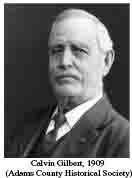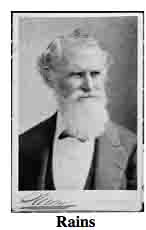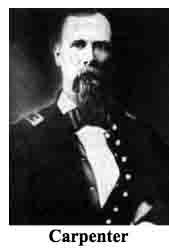
There are hundreds of rifles & guns displayed @ Gettysburg, many of them flanking monuments & markers. Such is the case with this artillery piece. The carriage, wheels, & limber all look well tended to & in good shape. The firing tube has a green patina from constant exposure to the elements. I peered into the bore and did not observe any rifling grooves, making this a smoothbore. There are several Confederate guns located here as this was a Rebel stronghold during the Battle. I learned the man who made the tablets which accompany the cannons also had a hand in restoring these cannons as well. The Park has hundreds of these historic artillery pieces on its field of battle. Their carriages, sights, and caissons, however, have been restored. Much of the restorative work came from Major Calvin Gilbert who owned the Gettysburg foundry.
The manufacturing of the gun carriages is an interesting story. After the war, Calvin Gilbert conducted a foundry @ Gettysburg and manufactured metal gun carriages to replce the rotted wooden ones. He also cast the battery tablet at this site as well as the other ones about the battlefield. Gilbert joined the 87th PA Volunteers when the "Rebellion" broke out. Since he was musically inclined, he was made a member of the regimental band. In early 1863, he was promoted to the rank of Captain and sent to Washington D.C. for commissary duty. He served in that capacity until the war ended in 1865, and at war’s end earned the brevet rank of Major.  After returning home to Gettysburg, Major Gilbert moved his family to the town of Chambersburg, where he served as the Superintendent of Schools. He also opened an iron foundry there in 1868. When Calvin learned, nearly thirty years later, in 1894, that the Gettysburg Foundry was available, he purchased it with a business partner & moved his family back to Gettysburg. For the next 20 years, the Gilbert Foundry created ironworks that are still seen today on many historic forts & nat'l battlefields (like the accompanying tablet), from upstate N.Y. to Florida to Lookout Mountain. Gilbert lived to be 100 years old and attended the Last Reunion of the Blue and Gray for the 75th anniversary of the Battle of Gettysburg when he was 99. He was a most remarkable man who lived an amazing life.
After returning home to Gettysburg, Major Gilbert moved his family to the town of Chambersburg, where he served as the Superintendent of Schools. He also opened an iron foundry there in 1868. When Calvin learned, nearly thirty years later, in 1894, that the Gettysburg Foundry was available, he purchased it with a business partner & moved his family back to Gettysburg. For the next 20 years, the Gilbert Foundry created ironworks that are still seen today on many historic forts & nat'l battlefields (like the accompanying tablet), from upstate N.Y. to Florida to Lookout Mountain. Gilbert lived to be 100 years old and attended the Last Reunion of the Blue and Gray for the 75th anniversary of the Battle of Gettysburg when he was 99. He was a most remarkable man who lived an amazing life.
There is an excellent excerpt in the American Guide Series about Gilbert attending the 75th reunion.

The two Napoleons &  Carpenter's Alleghany Artillery Tablet are located @ the intersection of Benner's Hill Loop & Hanover Rd, on the right or west side of the road when traveling south on Benner's Hill Loop. The monument is 669 feet south of the intersection. This tablet is the fourth curiosityto be visited, all along the same side of the road. The first stop turning off of Hanover Road is the
Carpenter's Alleghany Artillery Tablet are located @ the intersection of Benner's Hill Loop & Hanover Rd, on the right or west side of the road when traveling south on Benner's Hill Loop. The monument is 669 feet south of the intersection. This tablet is the fourth curiosityto be visited, all along the same side of the road. The first stop turning off of Hanover Road is the  Graham's Rockbridge Artillery Tablet (MN630-A), followed by
Graham's Rockbridge Artillery Tablet (MN630-A), followed by  Brown’s Chesapeake Artillery Tablet (MN620-A), and finally the
Brown’s Chesapeake Artillery Tablet (MN620-A), and finally the  Benner's Hill Interpretive, all of which lead to this monument. The monument is flanked by two 12-Pounder Confederate Napoleon guns, both manufactured at the Augusta Foundry of Augusta, Ga. If facing the tablet, to the right is gun no. 8 AF, to the left, gun no. 30 AF. Parking is available all up & down the narrow road. Take care to not park on anything remotely green looking as Park Police will happily ticket you. I visited this site on Monday, July 1, 2013 on the 150th anniversary of the Battle of Gettysburg @ 1:05 PM, EDT. As always, I used my trusty and oft abused Canon PowerShot 14.1 Megapixel, SX210 IS digital camera for the photos.
Benner's Hill Interpretive, all of which lead to this monument. The monument is flanked by two 12-Pounder Confederate Napoleon guns, both manufactured at the Augusta Foundry of Augusta, Ga. If facing the tablet, to the right is gun no. 8 AF, to the left, gun no. 30 AF. Parking is available all up & down the narrow road. Take care to not park on anything remotely green looking as Park Police will happily ticket you. I visited this site on Monday, July 1, 2013 on the 150th anniversary of the Battle of Gettysburg @ 1:05 PM, EDT. As always, I used my trusty and oft abused Canon PowerShot 14.1 Megapixel, SX210 IS digital camera for the photos.
My SOURCE for all things weapons at Gettysburg provided me explanatory information to understand the muzzle stamp. The following information appeared on the muzzle at the top or 12 o'clock position and then every quarter hour on the face. The registry information on the muzzle reads as follows:
8 AF ......1863 ......G.W.R. ......1144
Registry Information Explanation
No 8 AF Refers to the Army registration number, a way for the military to keep track of the guns when they take receipt of them from the various Confederate foundries. The AF refers refers to the Augusta Foundry (Govt Foundry & Machine Works) in Augusta GA and where this gun was manufactured. (More on that below) 1863 refers to the production date. G.W.R. refers to the ordnance officer responsible for inspecting the final product to make sure it met all standards. Those initials represent George Washington Rains. 1144 refers to the weight of the firing tube. This number is on the 9 o'clock position of the muzzle. Each gun is usually very unique and has its own weight which distinguishes it from every other gun, like a fingerprint. The carriages were approximately 900 pounds which makes this entire weapon approximately 2,100 pounds.
About the Inspector
George Washington Rains was the younger brother of the better known General Gabriel Rains.  Together, these two were known as the "Bomb Brothers" of the Confederacy. From what I read, G.W Rains was an intelligent, innovative and resourceful Confederate. During the war, the south did not have the natural resources to make gun powder for explosives. It seems Rains was a chemist. "Rains scoured the South looking for new sources of niter. Utilizing his chemistry background, Rains discovered soil found in the limestone caverns in Arkansas, Tennessee, Alabama, and Georgia could suffice and to make up the shortfall in production, he even employed systems of trenches to collect human waste latrines in larger cities."
Together, these two were known as the "Bomb Brothers" of the Confederacy. From what I read, G.W Rains was an intelligent, innovative and resourceful Confederate. During the war, the south did not have the natural resources to make gun powder for explosives. It seems Rains was a chemist. "Rains scoured the South looking for new sources of niter. Utilizing his chemistry background, Rains discovered soil found in the limestone caverns in Arkansas, Tennessee, Alabama, and Georgia could suffice and to make up the shortfall in production, he even employed systems of trenches to collect human waste latrines in larger cities."
Rains converted factories in Nashville & Richmond into small powder works, but his greatest achievement was in constructing from scratch the Augusta Powder Works in Augusta, Georgia. At its peak, the factory produced 7,000 pounds of powder in a day for a wartime total of 2,750,000. Rains revolutionized the gunpowder industry and instituted safety reforms that dramatically reduced injury at his factory.
George Rains stayed in Augusta and served as professor of chemistry and pharmacy at the Medical College of Georgia until 1884 and eventually moved to New York State to start a new business in 1894 before dying there in 1898. SOURCE
About the Foundry
The Augusta Foundry was one of several “government” foundries established during the war to furnish ordnance to the Confederates. The foundry used some of the facilities of the pre-war Augusta Arsenal, seized in January 1861. To complete the facility, the Augusta Foundry & Machine Works became a casting facility. Equipment came in from various sources. Much of it, the C.S. gov't purchased from civilian firms across the deep south. Augusta Foundry came on line just as many private foundries, from New Orleans, Nashville, and Memphis in particular, were overrun by the Federals. Starting in late 1862, Augusta produced a substantial number of 12-pdr Napoleons. Most of these were earmarked for the desperate Army of the Tennessee & other formations in the Western Theater. The Napoleons from Augusta matched the “Type 5" category identified by modern artillery historians. Augusta Foundry produced between 110 and 130 12-pdr Napoleon guns. Of the nearly fifty survivors, none have production dates beyond 1864. SOURCE The Augusta plant was the only official gov't structure constructed by the Confederacy & it continued to produce gunpowder until the very end of the war. Following the war, Federal officials deemed confiscated Confederate powder to be of the finest quality. The chimney, part of the original Confederate Powder Works, survives today. SOURCE
About the Gun
The 12-pound cannon "Napoleon" was the most popular smoothbore cannon used during the war. It was named after Napoleon III of France and was widely admired because of its safety, reliability, & killing power, especially at close range. The Federal version of the Napoleon can be recognized by the flared front end of the barrel, called the muzzle-swell. Confederate Napoleons were produced in at least six variations, most of which had straight muzzles, but at least eight catalogued survivors of 133 identified have muzzle swells This bronze gun does not have that flare. Casting of these bronze Napoleons by the Confederacy ceased due to lack of resources and in January 1864 Tredegar began producing iron Napoleons. Just before this in early 1863, resources were so scarce, Robert E. Lee sent nearly all of the C.S.'s bronze 6-pounder guns to Tredegar (another foundry) to be melted down and recast as Napoleons. SOURCE
Commonly referred to as the "Napoleon", this bronze smoothbore cannon fired a 12-pound ball & was considered a light gun through each weighed an average of 1,200 pounds. This powerful cannon could fire explosives shell & solid shot up to a mile and charges of canister up to 300 yards with accuracy. The Napoleon was a favorite amongst some Northern artillerists because of its firepower and reliability. Two Union batteries armed with Napoleons at Gettysburg were very effective in holding back Confederate infantry attacks & knocking down opposing southern batteries. Battery G, 4th U.S. repeatedly slowed Confederate infantry attacks against the 11th Corps lines on July 1, while Captain Hubert Dilger's Battery G, 1st Ohio Light Artillery almost annihilated two Confederate batteries w/ accurate & punishing counter-battery fire at long distance. Most Union Napoleons were manufactured in Mass. by the Ames Co. & the Revere Copper Co. SOURCE
12-pounder bronze gun, Model of 1857 Specifications
| Tube Material |
Bronze |
|---|
| Tube Weight |
1,227 lb (557 kg) |
|---|
| Powder Charge |
2.5 lb (1.13 kg) |
|---|
| Range (5° Elevation) |
1,619 yd (1,480 m) |
|---|
| At Gettyburg |
142 |
|---|
About the Battery:
 The Alleghany Artillery served as a member of Latimer's Battalion, Johnson's Division, Ewell's 2nd Corps. Carpenter's Battery was a famed C.S. artillery unit. The unit lost 26% of the 91 engaged here. The battery was commanded at Gettysburg by Captain John C. Carpenter (January 17, 1839 - December 29, 1912). Carpenter was born in 1839 at Covington, Va, serving as Captain of the battery after his brother Joseph was wounded, commanding the battery through many engagements, including 15 major battles. He lost an arm in combat at the Battle of Fisher's Hill, but survived the war.
The Alleghany Artillery served as a member of Latimer's Battalion, Johnson's Division, Ewell's 2nd Corps. Carpenter's Battery was a famed C.S. artillery unit. The unit lost 26% of the 91 engaged here. The battery was commanded at Gettysburg by Captain John C. Carpenter (January 17, 1839 - December 29, 1912). Carpenter was born in 1839 at Covington, Va, serving as Captain of the battery after his brother Joseph was wounded, commanding the battery through many engagements, including 15 major battles. He lost an arm in combat at the Battle of Fisher's Hill, but survived the war.
The tablet narrates the events associated w/ this battery from July 2-4 & reads as follows:
 Army of Northern Virginia
Army of Northern Virginia
Ewell's Corps - Johnson's Division
Latimer's Battalion - Carpenter's Battery
The Allegheny Artillery
Two Napoleons and Two 3 inch Rifles
July 2 The Battery took a prominent part in the cannonade against the Union Artillery on East Cemetery Hill and other points which began about 4 p.m. and continued over two hours. Some of the Union guns on the left enfiladed the Battalion and caused the Battery to suffer severely and having exhausted its ammunition it was ordered to withdraw.
July 3 Remained in reserve and not engaged.
July 4 Withdrew from the field with the Battalion.
Losses - Killed 5 - Wounded 24 - Horses Killed 9